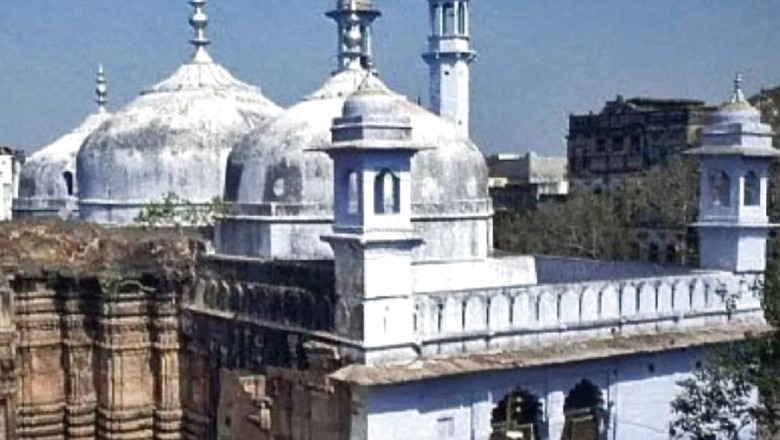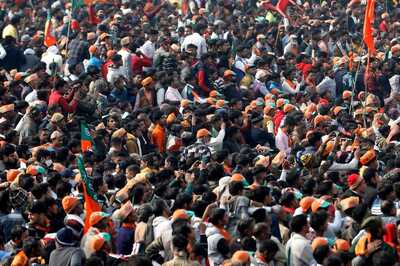
views
Turning on the news these days usually entails listening to shrieking voices over the Gyanvapi Mandir in Kashi. The mosque’s name is said to have come from an adjacent well, known as the Gyanvapi or the Well of Knowledge. The fact that it — ostensibly — is the only mosque in the world with a Sanskrit name eschews human logic, but it is what it is!
The present-day debate over the Gyanvapi temple is not the first. Since 1194, the masjid has been a bone of contention. The so-called ‘flag-bearers’ of Nehruvian secularism, the ‘devotees’ of the Constitution and the ‘believers’ of Islam, especially the ‘chieftains’ — the clerics and ulema — have been caught on the wrong foot this time. Part of this trepidation arises from the fear of losing the VETO they have enjoyed hitherto. Part of this nervousness comes from the fact that the Constitution is being followed verbatim, upholding its true spirit — with no compromises. Using acrimonious and obscene language on national television no longer suffices to gratify the Muslim clerics, so they must laud and extol the gory Timurids — also known as Mughals — and their grisly Islamic invasion. This is the very cabal that has an uncanny scorn and loathing for anything and everything (invariably and inexorably) innately indigenous. Simply put, anything and everything that has Hindu roots.
Both A.S. Altekar and Hiuen Tsang’s historical accounts, which were documented under the Indian Evidence Act of 1872, mention a temple and a hundred-feet-long Shiva Linga. As per Altekar’s 1937 book History of Benares: From the Earliest Times Down to 1937, which was written when he was the dean of Banaras Hindu University’s Department of Ancient Indian History and Culture, the Gyanvapi Mosque is said to have been mounted in 1669 under the reign of Aurangzeb, who ordered the razing of the ancient Vishweshwar temple and the erection of a mosque in its place.
On May 14, 1937, Professor Paramatma Sharan, a Banaras-born historian, made a declaration on behalf of the British government wherein he cited portions from Maasir-I-‘Alamgiri, written by the historian during Aurangzeb’s period, which claimed that Gyanvapi Mosque was a temple in the 16th century. The temple’s plinth was unharmed and served as the mosque’s courtyard. One of the walls was saved as well, and it became the qibla wall, the mosque’s most elaborate and essential wall facing Mecca. The mosque was constructed using materials from the fallen temple. There was no temple on the site for more than a century after the mosque was constructed.
In the 18th century, Rani Ahilyabai Holkar of Indore built the current Kashi Vishwanath temple to the south of the mosque. It has become one of the most important and beloved Hindu religious centres over the years. Instead of facing the sanctum sanctorum of the temple, an antique sculpture of the Nandi (bull) within the enclosure of the current Kashi Vishwanath temple faces the mosque’s wall. It is said that Nandi stands facing the old Vishweshwar temple’s sanctum sanctorum. Many Hindus have long believed that during Aurangzeb’s invasion, the original lingam of the ancient Vishweshwar temple was hidden by priests in the Gyanvapi well, which has sparked a desire to perform puja and rites at the pious site where the mosque now sits.
The vehement contempt against Hindus and their culture isn’t the making of the RSS or the BJP, as it is made out to be by the Lutyens’ cabal and their comrades. And so, this case isn’t entirely new either, for it was filed in the district court against the British government by then Muslim groups to avail the right to offer namaz in the entire Gyanvapi complex in 1936. Despite the fact that seven witnesses appeared on behalf of the claimants while 15 appeared on behalf of the British government, the right to offer namaz in the Gyanvapi mosque was granted on August 15, 1937. Alas, this date is a game of fate! It was further explicitly stated that such prayers couldn’t be offered anywhere else in the Gyanvapi complex. On April 10, 1942, upholding the decision of the lower court, the High Court dismissed the appeal.
On October 15, 1991, Pandit Somnath Vyas, Dr Ramrang Sharma and a few others petitioned the court for permission to build a new temple in Gyanvapi, as well as the right to worship. In 1998, Anjuman Inazaniya Masjid and the UP Sunni Waqf Board, Lucknow had two petitions filed on their behalf against this order. Vijay Shankar Rastogi, former district government advocate, was appointed as a litigant in this case on October 11, 2018. An order was issued to carry out an archaeological survey in the complex on April 8, 2021, which began on April 14, 2022.
What is even more hard to digest is that invaders who lived in tents and never erected a structure claimed to have built magnificent marvels in India. It is indeed a charade concocted and peddled by the (pseudo) left-liberals, which conceals and obliterates the fact that no matter if it is the Kashi Vishwanath temple, the Ram Mandir, the Kali temple of Kashmir, the Krishna temple of Mathura, the Atala Devi temple of Jaunpur, Saraswati temple of Bhojshala or the temple found under the mosque in Mangaluru, all Islamic structures stand on desecrated places of worship of the indigenous inhabitants of Bharat, the Hindus.
ALSO READ | Sadhguru Writes: Kashi is Eternal, Kashi Vishwanath Not about Specific Religion, It is for the World
Notwithstanding India being a Hindu-majority country which bequeathed its land to create the Islamic Republic of Pakistan and Bangladesh, different litigations on matters of faith and places of worship have went on for almost 70 years since Independence. Here too, the votaries of ‘orthodox’ Islam often suffer from selective amnesia: hailing the parliamentary mandate through the Places of Worship (Special Provisions) Act, 1991 but rejecting the duly passed Citizenship (Amendment) Act by Parliament. Leveraging court verdict on Taj Mahal survey appeal while repudiating the apex court decision on right to alimony for Shah Bano. All India Majlis-e-Ittehadul Muslimeen (AIMIM) supremo Asaduddin Owaisi dismissing the apex court verdict on Ayodhya Ram Mandir is yet another example.
Joint secretary of Anjuman Intezamiya Masjid Syed Mohammad Yasin took jibes at the judicial process and asked, if the law orders them to get beheaded, should they comply. However, he wouldn’t expect any suo-moto action, but the judges involved in the case have raised concerns over their and family’s safety. Unsurprising, right? But what is even more ironical is that amid all this Mr Akbaruddin Owaisi finds time to visit the tomb of Aurangzeb, a plunderer known to slaughter Indians, when the controversy around Gyanvapi is brewing. Isn’t this an attempt at rabble-rousing and provocation? Time is propitious to remember Dr Ambedkar who rightly called this the ‘gangster’s method of politics’, characterised by never-ending and ever new unreasonable demands, followed by acrimony, denunciations, street rioting and victim-playing. The Islamic cavalry pontificates secularism, believes in mobocracy and perpetuates riots!
“India is the cradle of the human race, the birthplace of human speech, the mother of history, the grandmother of legend, and the great grandmother of tradition… Our most valuable and most instructive materials in the history of man are treasured up in India alone,” American writer Mark Twain had once said. India’s history and culture are vibrant, dating back to the dawn of civilisation. It all started with an enigmatic civilisation that developed around the Indus River and in agricultural settlements in India’s southern states. By the end of the fourth millennium BC, India had become a very advanced society. Bharat, the most modern state in existence today, is the epitome of syncretic polytheism. India is and has been a land of pluralism par excellence. “The distinguishing characteristic of Indian civilisation is its capacity to absorb synergistically the culture of foreigners,” Daniel Patrick Moynihan, US ambassador to India from 1973 to 1975, is believed to have said.
Religion per se came to Bharat thanks to the Islamic invasions. Steven Ian Wilkinson of Yale University notes that the rising ethnic violence in Bharat stems from the augmented confessionalism, a specific religion-based power sharing arrangement in a democracy, and that no such arrangement can satiate the groups and will eventually lead to resentment. We as a civilisation date back to time immemorial but as a nation-state are fairly young but that doesn’t mean that we will bow to the vested interests, backed by western powers and unseen hands, that often tend to sermonise Bharat.
Yuvraj Pokharna is a Surat-based educator, columnist, and social activist. The views expressed in this article are those of the author and do not represent the stand of this publication.
Read all the Latest Opinions here


















Comments
0 comment